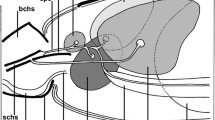Summary
In European green frogs the secretory activity of the subcommissural organ (SCO) was investigated and quantified measuring three parameters considered to be closely related to the cellular processes of synthesis and release of secretory material by the cells of the SCO: (1) the amount of stained secretory material in the SCO; (2) the amount of secretory material in the SCO labelled by a radioactive precursor; and (3) the growth rate of the “liquor (cerebrospinalis) fibre” (LF). A significant negative linear correlation appears to exist between the growth rate of the LF, on the one hand, and the amount of stained secretory material as well as the amount of radioactively labelled secretory material, on the other hand. A significant positive linear correlation exists between the amounts of stained material and radioactively labelled secretory material. The occurrence in the SCO of European green frogs of a larger amount of stained and/or of radioactively labelled secretory material is probably an expression of a lower (LF-producing) secretory activity. In the light of these observations the suitability of the three parameters as a measure of the secretory activity of the SCO is discussed.
Similar content being viewed by others
References
Bock R, Ockenfels H (1970) Fluoreszenzmikroskopische Darstellung Aldehydfuchsin-positiver Substanzen mit Crotonaldehyd-Diaminobenzophenon. Histochemie 21:181–188
Diederen JHB (1973) Influence of light and darkness on secretory activity of the subcommissural organ and on growth rate of Reissner's fibre in Rana esculenta L. Z Zellforsch 139:83–94
Diederen JHB (1975a) A possible functional relationship between the subcommissural organ and the pineal complex and lateral eyes in Rana esculenta and Rana temporaria. Cell Tissue Res 158:37–60
Diederen JHB (1975b) Influence of ambient temperature on growth rate of Reissner's fibre in Rana esculenta. Cell Tissue Res 156:267–271
Diederen JHB (1975c) The subcommissural organ and Reissner's fibre in Rana and their relationship with the pineal complex. Thesis, Utrecht
Diederen JHB, Vullings HGB (1980) A comparative study on the secretory activity of the subcommissural organ in the European green frogs: Rana esculenta, Rana lessonae and Rana ridibunda. Comp Biochem Physiol 66A: 593–597
D'Uva V, Ciarcia G, Ciarletta A (1979) The subcommissural organ of Lacerta s. sicula Raf.: Functional studies. Cell Tissue Res 200:323–327
Ermisch A, Sterba G, Mueller A, Hess J (1971) Autoradiographische Untersuchungen am Subcommissuralorgan und dem Reissnerschen Faden. I Organsekretion und Parameter der Organleistung als Grundlagen zur Beurteilung der Organfunktion. Acta Zool 52:1–21
Gabe M (1968) Techniques histologiques. Masson et Cie, Paris, pp 362–366
Hess J, Diederen JHB, Vullings HGB (1977) Influence of changes in composition of the cerebrospinal fluid on the secretory activity of the subcommissural organ in Rana esculents. Cell Tissue Res 185:505–514
Møllgård K, Lundberg JJ, Wiklund L, Lachenmayer L, Baumgarten HG (1978) Morphologic consequences of serotonin neurotoxin administration: neuron-target cell interaction in the rat subcommissural organ. Annals NY Academy of Sciences 305:262–288
Sterba G (1977) Das Subkommissuralorgan. In: Sterba G, Bargmann W (eds) Circumventriculäre Organe. Nova Acta Leopoldina Suppl 9:103–114
Wetzig H, Scharf JH, Krumbacher P, Liedel K, Marzotko D (1970) Kernvariationsstatistische Untersuchungen am Subcommissuralorgan der weissen Ratte nach chronischer Behandlung mit Methylthiouracil, Dijodtyrosin, p-Hydroxypropiophenon und Alloxan einzeln und in Kombination. Endokrinologie 56:97–108
Wijnands HEJ, van Gelder JJ (1976) Biometrical and serological evidence for the occurrence of three phenotypes of green frogs (Rana esculenta complex) in the Netherlands. Neth J Zool 26:414–424
Ziegels J (1976) The vertebrate subcommissural organ: a structural and functional review. Arch Biol (Bruxelles) 87:429–476
Ziegels J (1979) Secretory activity and histoenzymological characteristics in the subcommissural organ of hormone-injected ducks, Anas platyrhynchos. J Neural Transm 45:35–42
Zimmermann P, Paul E (1972) Reaktionsmuster verschiedener Mittel- und Zwischenhirnzentren von Rana temporaria L. nach Unterbrechung der Nervenbahnen des Pinealkomplexes. Z Zellforsch 128:512–537
Author information
Authors and Affiliations
Rights and permissions
About this article
Cite this article
Diederen, J.H.B., Vullings, H.G.B. Comparison of several parameters related to the secretory activity of the subcommissural organ in European green frogs. Cell Tissue Res. 212, 383–394 (1980). https://doi.org/10.1007/BF00236505
Accepted:
Issue Date:
DOI: https://doi.org/10.1007/BF00236505




